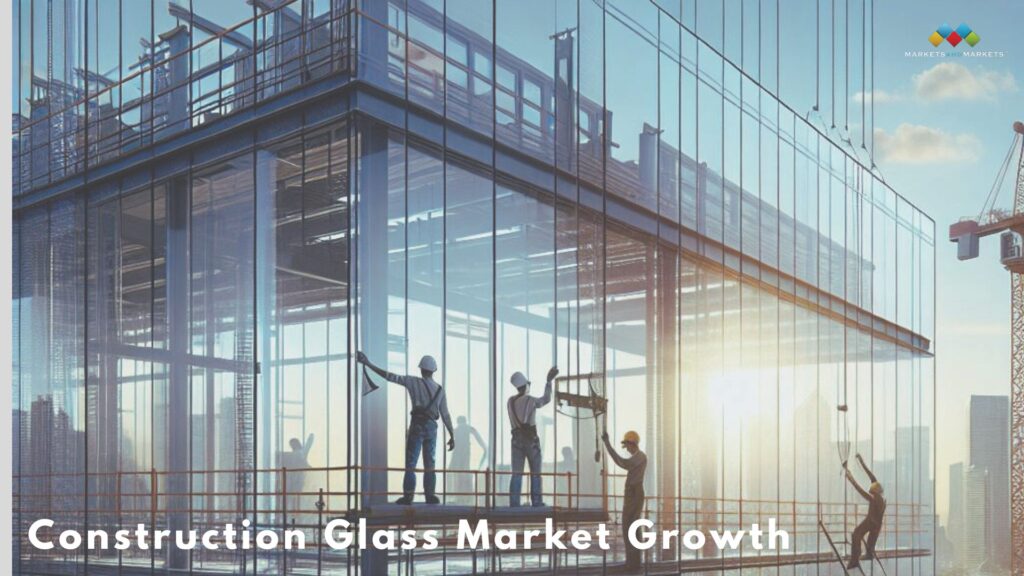
The construction glass market is evolving in unprecedented ways, shaped by the forces of rapid urbanization, groundbreaking technological advancements, and an increasing emphasis on sustainability. Construction Glass Market is valued at USD 112.0 billion in 2024 and is projected to reach USD 144.3 billion by 2029, growing at 5.2% cagr from 2024 to 2029.This strong growth trajectory offers abundant opportunities for professionals in both commercial and residential construction to enhance their projects with state-of-the-art glass solutions that improve both functionality and aesthetics.
Key Drivers Fueling Market Expansion
1. Urbanization and Infrastructure Growth
As cities grow and new infrastructure projects continue to emerge, the need for high-quality construction materials, especially glass, is rising at a rapid pace. This is especially evident in densely populated regions such as Asia, where countries like China and India are investing heavily in residential and commercial construction. These investments are spurring demand for glass products that provide both structural and aesthetic benefits, meeting the evolving needs of modern urban centers.
2. Embracing Sustainable Solutions
The construction industry is progressively shifting towards sustainable practices, with a significant focus on reducing energy consumption and minimizing environmental impact. Advanced energy-efficient glass products, such as low-emissivity (Low-E) glass, are becoming increasingly popular due to their ability to control heat transfer and improve energy efficiency. This kind of glass not only supports energy-saving goals but also brings a sleek, modern look to architectural designs, enhancing both the appeal and environmental performance of buildings.
3. Technological Advancements in Glass Production
Breakthroughs in glass manufacturing are enabling the development of specialized glass types that serve a wide range of architectural purposes. For instance, coated glass provides enhanced thermal performance and excellent solar control, making it a preferred choice for large commercial buildings and skyscrapers. These innovative products allow architects to design structures that are not only beautiful but also energy-efficient, comfortable, and durable.
Market Segmentation: Understanding Key Segments
The construction glass market is diverse, with various segments catering to specific applications and requirements.
By Application: This market can be divided into residential and commercial segments. While the residential sector remains the largest, driven by steady housing demands and renovation activities, the commercial sector is growing quickly as smart cities emerge and architectural designs evolve. Commercial projects are particularly benefiting from advanced glass products that improve energy efficiency and aesthetic value.
By Type: Flat glass is widely used in windows and facades due to its versatility and cost-effectiveness, making it the most common type in the market. However, special glass—including tempered, laminated, and smart glass—is seeing a surge in popularity thanks to its enhanced durability, safety, and energy performance, which make it ideal for high-rise buildings and specialized architectural projects.
By Geography: The Asia-Pacific region leads the global construction glass market, thanks to strong urbanization and infrastructure investments, especially in emerging economies. North America is also experiencing rapid growth, driven by an increasing focus on green building initiatives and stricter energy efficiency regulations, positioning it as a key player in sustainable construction.
Challenges to Consider in the Construction Glass Market
While the future is promising, the construction glass market does face certain challenges that professionals need to be aware of.
Raw Material Price Fluctuations: The cost of raw materials used in glass production can be highly volatile, affecting overall production expenses and, ultimately, pricing for consumers. This unpredictability can create financial challenges for manufacturers and impact project budgets for both residential and commercial clients.
Environmental Impact and Recycling Issues: As sustainability becomes central to construction practices, there is growing attention on the need to responsibly manage glass waste and improve recycling processes. Developing effective strategies for glass recycling and waste management is essential, not only to comply with regulatory standards but also to support global sustainability goals.
Future Outlook: Trends to Watch
The future of the construction glass market is filled with exciting developments and trends that have the potential to reshape the industry.
Smart Glass Technologies: The integration of smart technologies in glass will allow buildings to automatically adjust to environmental changes, thereby optimizing energy efficiency and enhancing occupant comfort. Smart glass can change its opacity or heat resistance in response to sunlight, contributing to significant energy savings.
Renovation and Retrofitting: With a growing focus on updating older buildings to meet modern energy standards, retrofitting projects are expected to be a major driver of demand for energy-efficient glass solutions. By incorporating high-performance glass, architects and builders can enhance building insulation, reduce energy consumption, and refresh the visual appeal of existing structures.
Sustainable Manufacturing Practices: As environmental awareness grows, the demand for eco-friendly construction materials, including glass, is on the rise. Manufacturers investing in sustainable production processes—such as reducing emissions and using recyclable materials—are likely to gain a competitive edge in this market, meeting both consumer demand and regulatory requirements for green construction.
For More Deeper Insights Download PDF Brochure :
The construction glass market is at a dynamic and transformative point, driven by urban expansion, a stronger focus on sustainable practices, and constant technological innovation. For industry professionals in commercial and residential construction, staying attuned to these trends is essential for leveraging the opportunities in this expanding market. Embracing advanced glass solutions allows for the creation of buildings that are not only energy-efficient and environmentally responsible but also visually striking and adaptable to future needs.
In a rapidly changing industry, understanding the market dynamics and integrating cutting-edge glass technologies into projects is key to staying competitive and contributing to a more sustainable built environment. Whether you’re designing the latest skyscraper or renovating a historic building, exploring the possibilities of modern glass solutions can elevate your projects, bringing value to both your clients and the communities you serve.